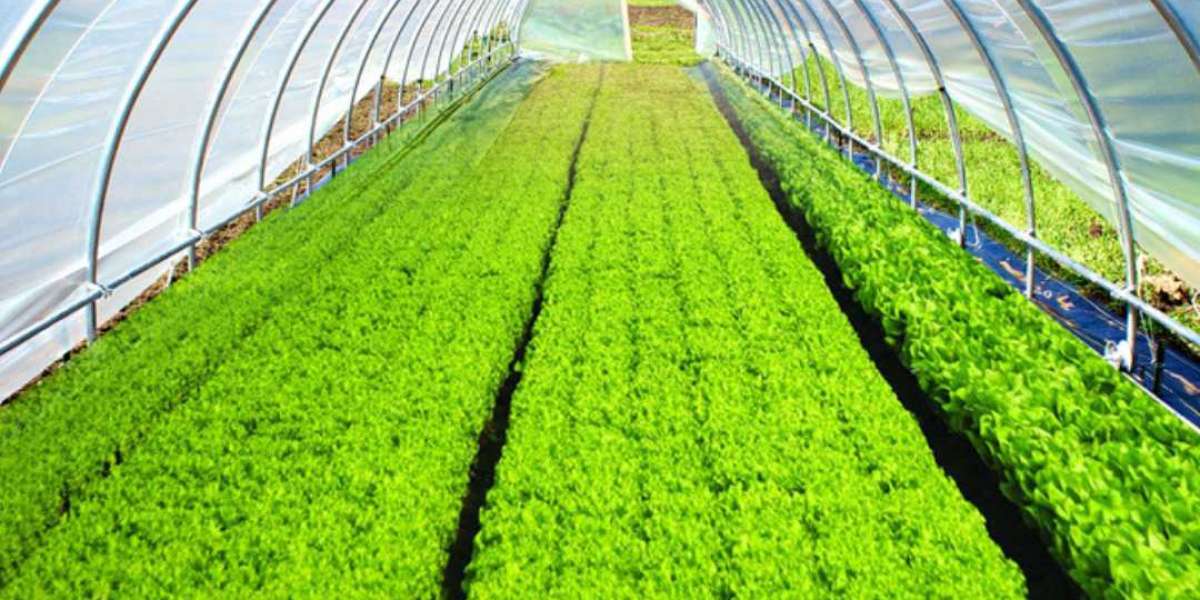In the realm of modern agriculture, innovation is crucial for increasing efficiency, maximizing yields, and ensuring sustainable practices. One of the most impactful advancements in this field is the development and use of greenhouse films. These films have revolutionized how we approach plant cultivation, offering numerous benefits that traditional methods simply cannot match. In this blog, we will explore what Greenhouse plastic manufacturers are, their benefits, applications, and how they can transform agricultural practices.
What are Greenhouse Films?
Greenhouse films are specialized plastic coverings used to create controlled environments for plant growth. These films cover the structure of greenhouses, protecting plants from external elements while optimizing conditions for growth. Made primarily from polyethylene, these films can be tailored to include various additives that enhance their performance, such as UV inhibitors, anti-drip properties, and thermal stabilizers.
Benefits of Greenhouse Films
The use of greenhouse films provides a multitude of benefits that significantly improve agricultural outcomes. Let's delve into some of the most noteworthy advantages:
Optimal Light Transmission
One of the primary functions of Greenhouse plastic rolls is to regulate light transmission. These films can be engineered to allow the optimal amount of sunlight to penetrate, ensuring that plants receive the necessary light for photosynthesis while preventing harmful UV rays from causing damage. This controlled light environment helps in promoting healthier and faster plant growth.
Temperature Regulation
Greenhouse films help in maintaining a stable internal temperature, protecting plants from extreme weather conditions. By trapping heat within the greenhouse, these films ensure that the temperature remains conducive to plant growth even during colder months. Some films also come with thermal properties that reduce heat loss at night, further stabilizing the internal climate.
Enhanced Durability
Modern greenhouse films are designed to withstand harsh weather conditions, including strong winds, heavy rain, and snow. They are also resistant to UV radiation, which can degrade plastics over time. This durability ensures a longer lifespan for the greenhouse covering, reducing the need for frequent replacements and thus lowering overall costs.
Water Conservation
Greenhouse films with anti-drip properties prevent the formation of water droplets on the film's interior surface. These droplets can fall onto plants, potentially causing disease and hindering growth. By preventing dripping, these films help maintain a more controlled and healthier growing environment, reducing water waste and promoting efficient water use.
Pest and Disease Control
By creating a barrier between the external environment and the plants, greenhouse films help in significantly reducing the incidence of pests and diseases. This controlled environment minimizes the need for chemical pesticides, promoting healthier crops and reducing the environmental impact of agriculture.
Applications of Greenhouse Films
Greenhouse films are incredibly versatile and can be used in various agricultural and horticultural applications. Here are some common uses:
Vegetable and Fruit Cultivation
Greenhouse films are extensively used in the cultivation of vegetables and fruits. The controlled environment ensures that crops are protected from adverse weather, pests, and diseases, leading to higher yields and better quality produce. This is particularly beneficial for high-value crops such as tomatoes, cucumbers, strawberries, and bell peppers.
Flower and Ornamental Plant Production
The ornamental plant industry also benefits greatly from the use of greenhouse films. Flowers and decorative plants often require specific climatic conditions for optimal growth, which can be easily maintained using greenhouse films. This ensures a consistent supply of high-quality ornamental plants and flowers year-round.
Seedling and Nursery Operations
For nurseries and seedling operations, greenhouse films provide the ideal environment for young plants to grow. The controlled conditions help in ensuring a high germination rate and healthy seedling development, which is crucial for successful transplantation and subsequent growth.
Research and Development
Greenhouse films are widely used in agricultural research and development. Controlled environments are essential for conducting experiments and trials on new plant varieties, pest control methods, and growth techniques. The ability to manipulate and monitor environmental conditions precisely makes greenhouse films indispensable in this field.
Choosing the Right Greenhouse Film
Selecting the appropriate greenhouse film is critical for maximizing the benefits and ensuring the success of your agricultural endeavors. Here are some factors to consider when choosing a greenhouse film:
Material Quality
High-quality polyethylene is the most commonly used material for greenhouse films due to its durability and flexibility. Ensure that the film you choose is made from virgin polyethylene, as recycled materials may not offer the same level of performance.
Thickness
The thickness of the film affects its durability and insulation properties. Thicker films are more durable and provide better insulation but may be less flexible. Common thicknesses range from 4 mils (0.1 mm) to 12 mils (0.3 mm), with 6 mils (0.15 mm) being a popular choice for its balance of durability and flexibility.
UV Protection
UV radiation can degrade plastic over time, so it's essential to choose a film with UV inhibitors that extend its lifespan. UV-protected films also help in preventing damage to plants from harmful UV rays.
Anti-Drip Properties
Anti-drip or anti-condensate films prevent the formation of water droplets on the interior surface of the greenhouse. This is particularly important for maintaining a healthy growing environment and preventing disease.
Thermal Properties
Films with thermal additives help in reducing heat loss, maintaining a more stable temperature inside the greenhouse. This is especially beneficial in regions with significant temperature fluctuations between day and night.
Light Diffusion
Films with light diffusion properties scatter sunlight, ensuring even light distribution within the greenhouse. This prevents hotspots and ensures that all plants receive adequate light for optimal growth.
Installation and Maintenance Tips
Proper installation and maintenance are crucial for maximizing the lifespan and effectiveness of greenhouse films. Here are some tips:
Installation
Ensure that the greenhouse frame is clean and free of sharp edges that could damage the film. Secure the film tightly to avoid flapping in the wind, which can cause wear and tear. Use appropriate fasteners and make sure the film is stretched evenly to prevent sagging.
Maintenance
Regularly inspect the greenhouse film for any signs of damage or wear. Clean the film periodically to remove dirt and dust that can block sunlight. Repair any small tears or holes immediately to prevent them from becoming larger issues.
Seasonal Adjustments
In regions with extreme seasonal changes, consider using double-layer films for added insulation during winter months. Remove snow accumulation promptly to prevent damage to the greenhouse structure and film.
The Future of Greenhouse Films
As technology advances, the future of greenhouse films looks promising. Innovations in materials science are leading to the development of films with enhanced properties, such as improved light transmission, greater durability, and better environmental resistance. Additionally, research into biodegradable and recyclable films aims to further reduce the environmental impact of agricultural practices.
Smart greenhouse technologies are also on the rise, integrating sensors and automated systems to monitor and control environmental conditions within the greenhouse. These advancements will enable even more precise control over plant growth, leading to higher yields and more efficient use of resources.
Conclusion
Greenhouse films have undeniably transformed modern agriculture, offering a plethora of benefits that enhance plant growth, improve yields, and promote sustainable practices. From vegetable and fruit cultivation to ornamental plant production and agricultural research, these versatile films provide a controlled environment that meets the diverse needs of different crops.
By understanding the benefits, applications, and factors to consider when choosing and maintaining greenhouse films, farmers and horticulturists can make informed decisions that optimize their agricultural operations. As we look to the future, continued innovation in greenhouse film technology promises to further revolutionize the way we grow and sustain our crops, ensuring a more efficient and environmentally friendly approach to agriculture.
Embrace the power of Greenhouse poly film suppliers and unlock the full potential of your agricultural endeavors with the advanced solutions offered by these remarkable materials.
Frequently Asked Questions (FAQs):
What are the primary benefits of using greenhouse films from Singhal Industries for agricultural purposes?
Greenhouse films from Singhal Industries offer several key benefits, including optimal light transmission, temperature regulation, enhanced durability, and water conservation. These films are designed to allow the right amount of sunlight to penetrate while blocking harmful UV rays, ensuring healthier and faster plant growth. They help maintain stable internal temperatures, protecting plants from extreme weather conditions and reducing heat loss at night. Additionally, the films are durable and resistant to UV radiation, ensuring a longer lifespan. Their anti-drip properties prevent water droplets from forming on the interior surface, reducing the risk of disease and promoting efficient water use.
How can Singhal Industries' greenhouse films contribute to sustainability and environmental protection in agriculture?
Singhal Industries' greenhouse films are an environmentally friendly choice as they are made from high-quality polyethylene that can be tailored with various additives to enhance performance and longevity. The films help reduce the need for chemical pesticides by creating a barrier against pests and diseases, promoting healthier crops with minimal environmental impact. Furthermore, the energy-efficient manufacturing process of these films and their ability to conserve water and maintain stable growing conditions contribute to more sustainable agricultural practices, aligning with modern eco-conscious design trends.
What should I consider when selecting greenhouse films from Singhal Industries for my specific agricultural needs?
When choosing greenhouse films from Singhal Industries, it's important to consider factors such as material quality, thickness, UV protection, anti-drip properties, thermal properties, and light diffusion. Opt for films made from high-quality virgin polyethylene for durability and flexibility. The thickness of the film affects its insulation and durability, with common options ranging from 4 mils to 12 mils. Ensure the film includes UV inhibitors to prevent degradation from sunlight and protect plants from harmful UV rays. Anti-drip films prevent water droplets from forming inside the greenhouse, while thermal properties help maintain stable temperatures. Light diffusion properties ensure even light distribution, preventing hotspots and promoting uniform plant growth








